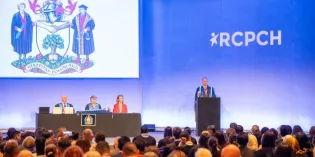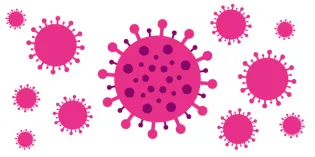This position statement was updated on 6 December 2023
Key facts
- Vaccination is proven to be a highly effective intervention to prevent disease.1
- Globally, vaccination is estimated to prevent 2 – 3 million deaths per year.1
- In the UK vaccines are routinely offered against 18 infections in childhood and adolescence 2 . As a result, some of these diseases have become very uncommon, with a substantial saving in morbidity and mortality.
- Routine vaccination is the norm in the UK with the majority of parents confident in the vaccine programme,3 however coverage of all childhood vaccines has declined in recent years and no vaccine met the World Health Organisation's 95% target uptake rate4 . There are additional inequalities in vaccine uptake between population groups and geographical areas.
- Children and young people with long term conditions are an example of an under vaccinated group. For example, only 12.6% of children aged between 6 months and 2 years with neurological problems (eg cerebral palsy) received ‘flu vaccine in 2022-23.5
Key considerations
- There is a considerable body of high-quality evidence demonstrating the safety and effectiveness of vaccines.6
- Immunisation not only protects individuals, but through herd (community) immunity, protects those who cannot be immunised due to their young age or in whom vaccination is contraindicated because of an underlying condition.
- ‘Vaccine hesitancy’, defined as ‘delay or refusal of vaccine in the presence of services’, has been identified by the World Health Organization as one of the top ten threats to global health. However, there is no evidence that this is a major issue in the UK, where vaccine confidence is high and under vaccination is more often due to difficulties accessing services for practical or logistical reasons.7 8
- In the UK, it is estimated only about 1-2% parents refuse all vaccines.9
- Mandation of vaccination, whether by attaching it to school entry or welfare benefits has been suggested as a means of increasing vaccine uptake. The evidence of benefit in other countries is tenuous and there is no evidence applicable to UK. Ensuring the interventions known to be effective in achieving high vaccine uptake rates, ie providing accessible/flexible services, and use of reminders and recall should be fully implemented. Analysis of the potential positive and negative impacts of mandatory vaccination should be conducted before introducing such a policy.10 Mandation could be counterproductive with parents withdrawing children from school or paying fines and making families further impoverished. Indeed some parents who were not initially anti-vaccine, may object to the state telling them what to do and therefore refusing to have their children immunised.11 12
- The COVID-19 pandemic has further increased missed opportunities for routine vaccination uptake in children and young people due to parental concerns about visiting GP surgeries and prolonged school closures. Many children and young people who missed out on their vaccines during this period need to be caught up.
Economic impact
- Before any vaccine is introduced part of the assessment includes evidence of cost effectiveness. Both HPV13 and Meningitis B14 vaccines have been shown to be cost-effective, though not cost saving.
- Older more established vaccines may be cost saving. For the routine US schedule in United States of America in 2001, consisting of vaccines against diphtheria, tetanus, pertussis, Hib, polio, measles, mumps, rubella and chickenpox, it was calculated that for every $1 spent there was a saving of $5 in direct costs and a further $11 in societal costs.15
- In drawing up guidance for reducing disparities in immunisation uptake in the under 19s, modelling of the MMR vaccine, showed that even home delivered vaccination would be cost effective.16
Key messages for health professionals
- Health professionals should follow national guidance. For example, NICE guidance on Vaccine Uptake in the General Population 16 , and Reducing Health Inequalities by NHS Health Scotland.17 NICE guidance includes recommendations on the targeting of groups at risk of not being fully immunised. It recommended a number of initiatives, including improving access to immunisation services; provision of accurate up to date information to parents and young people; checking immunisation status of new migrants and looked after children and offering outstanding vaccinations.
- Assessing children’s immunisation status should form part of any assessment. When vaccines are not up to date, the reason should be established and appropriate intervention taken. Parents may have delayed or refused vaccines for a variety of reasons. These parents should be offered the opportunity to discuss their concerns. Some children will not have been vaccinated because of false contraindications e.g. egg allergy is still commonly considered to contraindicate MMR vaccine, whereas this is no longer the case.18
- Health Professionals should check guidance on which vaccines are required at different ages. Although there is no upper age limit for most vaccines, vaccine requirements do change with age and so it is important to check. Public Health England publishes an algorithm to assist in determining which vaccines are required.19
- It is particularly important when seeing children with allergies, that it is made clear that this should rarely interfere with vaccination. How this relates to an individual child’s allergies should be explained to the parents and recorded in the GP letter.
- Many parents have questions and concerns about vaccines. Evidence suggests that an effective interaction can positively influence a parent’s view of vaccines and parents who have previously delayed or declined vaccines may reverse this decision.20 21 Although there is no good evidence to show that UK parents’ vaccine decisions are influenced by misinformation on social media, many parents seek out or are exposed to information on social media and the Internet more generally. Since not all the information available from these sources is reliable, it is important for health care professionals caring for children to be equipped to discuss immunisation with parents. This does not just mean being knowledgeable about vaccines; the style of conversation is vital to gain parents’ trust and to support them in their decision making. There are some useful resources with guidance on communicating vaccine issues with parents.22 23 24 Talking with parents about vaccination is time well spent.
- Health professionals should be aware of groups at risk of low vaccine uptake. They include: children in large families, children in lone parent families, looked after children, children in mobile families including the travelling community, children in some ethnic minority groups, children with chronic conditions or disability.
RCPCH recommendations
RCPCH strongly supports immunisation, the promotion of immunisation, including the provision of advice to parents and young people and advocates for national policies, and practices that support the immunisation programme.
The College welcomes the new NHS Vaccination Strategy and recommends the swift implementation of its proposals to improve vaccine uptake.
The UK Government should:
- Provide resources to expand access and capacity of vaccine appointments to provide more flexible access to families.
- Prioritise the development of an integrated child health record to enable access to key data for all child health professionals.
- Accelerate the development of the Digital Child Health Record
- Take forward the commitments from the Health and Care Act on bringing in a consistent child identifier to improve multi-agency information sharing to improve children’s health.
Health bodies
- The NHS should take a renewed focus on vaccination and ensure full implementation of national guidance, for example, NICE recommendations for reducing differences in immunisation uptake.25
- UK Health Security Agency (UKHSA), Health Protection Scotland, Public Health Wales and Northern Ireland’s Public Health Agency Health should continue to ensure the provision of accurate data on infectious diseases and vaccination coverage in the UK.
- National funding bodies should commission research into strategies to address vaccine hesitancy and refusal and tailoring interventions appropriately.
- Teaching and training health professionals in immunisation issues and discussing vaccination with parents should be included in the national undergraduate and postgraduate medical curricula. This should be based on national training standards and core curricula published in the revised National Minimum Standards and Core Curriculum for Immunisation Training for Registered Healthcare Practitioners published by UKHSA (formerly Public Health England) and the Promoting Effective Immunisation Practice Guide published by NHS Education for Scotland.26 27
- All other agencies should prioritise routine vaccination uptake to address the large number of children and young people who missed out during the COVID-19 pandemic and need to be caught up to obtain protection. This may be particularly important for children who are not attending regular school post COVID.
RCPCH activity to promote immunisation
- RCPCH is committed to encouraging members to ensure that parents and young people with whom they have contact, are given full and accurate information about vaccination.
- This includes continuing to encourage our members to give greater consideration of provision of opportunistic vaccination, for example in hospitals and community clinics.
- RCPCH publishes ‘Vaccines in Practice’ online e-learning, which is mapped to the paediatric and GP curricula, to support paediatric and GP trainees to develop skills in communicating the benefits of vaccination.
- RCPCH will continue to collaborate with other professional organisations such as RCGP, RCN, RCM, iHV, FFPH, Society of Immunology, Unite CPHVA to promote vaccination.
Case studies
Examples of the impact of vaccination include the introduction of vaccines to prevent measles and meningococcal group C disease in the UK.
Case study: Meningococcal CThe MenC vaccine was introduced into UK in 1999. Before its introduction, meningococcal serotype C was one of the most common causes of meningitis and septicaemia with 823 confirmed cases in 1998.28 The incidence of MenC disease fell by 86% in vaccinated groups in first 18 months of the programme. Over the years, the number of doses offered to infants has been reduced and in 2016 the remaining infant dose was removed as disease rates are so low and infants are protected by herd immunity. Since 2016, children are offered only one dose of Men C at 12 months of age and MenACWY replaced Men C vaccine for 14-year olds in 2015.29 Further changes to the schedule have been announced. From 2025 Menitorix (MenC/Hib) will be withdrawn by the manufacturers. JCVI has recommended that this infant dose is no longer needed due to the decline in meningococcal disease in the UK caused by strains A,C,W,Y. JCVI recommends that infants can continue to be protected against MenC indirectly through the MenACWY vaccine given to teenagers. It is advised that an additional dose of a Hib containing vaccine should be given at 18 months of age. Additionally the second dose of MMR vaccine, given at 3 years 4 months should be brought forward to 18 months. These changes will require an additional vaccination visit. |
Case study: Measles
Before the single measles vaccine was introduced into the UK in 1968, measles notifications ranged between 160,000 – 800,000 annually, peaking every two years with over 600 deaths between 1960-1967. As vaccine uptake increased notifications decreased but measles remained endemic. In 1988, MMR vaccine was introduced with the aim of eliminating measles, mumps, rubella and congenital rubella syndrome. By 1996 uptake of the vaccine was 91.8% and endemic transmission of measles was interrupted.
However, the publication of the now discredited paper in 1998 shook public confidence in the vaccine and uptake fell to 79.9% in 2003-04. Outbreaks of measles and mumps began to occur from 2002. As public confidence in the vaccine was restored, vaccine uptake gradually recovered and in 2013-14, 94.1% of five-year-olds received at least one dose of MMR with 88.3% receiving the complete course of two doses.30
However, the uptake of MMR, along with that of other vaccines has fallen more recently and there has been an increase in disease such that the UK has had its elimination status withdrawn. In recent outbreaks, the epidemiology of measles has changed, and a relatively high proportion of cases occur in older adolescents/young adults.31 These are the people who were not vaccinated due to public concerns over the vaccine in the early 2000s.
In 2023 UKHSA published data showing that unless MMR vaccine coverage improves, with catch up for people who missed out when they were younger, a measles outbreak of between 40,000 – 160,000 cases could occur in London. This is due to low uptake over many years in London, particularly in some areas and among some population groups. Currently, a quarter of five years olds in London have not had two doses of MMR vaccine.3
Resources available to support immunisation conversations and to direct parents to include:
NHS website: vaccinations - This is information for the general public
UKHSA: immunisation Information for health professionals and immunisation practitioners - This is the main website for immunisation information in England and enables access to Immunisation against Infectious Disease (the ‘Green Book’), factsheets, leaflets, Q&As for health professionals, Vaccine Update, etc.
Vaccine Knowledge Project: Oxford Vaccine Group - This provides more detailed responses to parental questions and concerns. This also includes a film of a mother describing the impact of SSPE on her adult daughter who contracted measles in infancy. All the information on the website can be translated into many languages.
Vaccine Education Center – Children’s Hospital of Philadelphia - This is based in USA and so some vaccines or timings are not applicable, but it is a useful source of information on many vaccine questions.
Immunisation eLearning from eLfH
Vaccines in practice – online learning. RCPCH - This is designed to facilitate the development of skills in communicating the benefits of vaccination
- 1 a b World Health Organization. Immunization. https://www.who.int/topics/immunization/en/#
- 2UKHSA. Complete routine immunisation schedule. 17 September 2019. www.gov.uk/government/publications/the-complete-routine-immunisation-schedule.
- 3 a b https://www.gov.uk/government/publications/childhood-vaccines-parental-attitudes-survey-2022
- 4NHS England. Childhood Vaccination Coverage Statistics. 2022-23 digital.nhs.uk/data-and-information/publications/statistical/nhs-immunisation-statistics
- 5UKHSA. Seasonal influenza vaccine uptake in GP patients: 2022-2023 assets.publishing.service.gov.uk/government/uploads/system/uploads/attachment_data/file/1177042/GP-patients-flu-annual-report-2022-2023.pdf
- 6UKHSA Immunisation against infectious disease. 2020 www.gov.uk/government/collections/immunisation-against-infectious-disease-the-green-book#the-green-book
- 7UKHSA. Increasing vaccine uptake: Strategies for addressing barriers in primary care. 2019. publichealthmatters.blog.gov.uk/2019/05/16/increasing-vaccine-uptake-strategies-for-addressing-barriers-in-primary-care/
- 8Royal Society of Public Health. Moving the Needle: Promoting vaccination uptake across the life course. 2019. www.rsph.org.uk/our-work/policy/vaccinations/moving-the-needle-promoting-vaccination-uptake-across-the-life-course.html
- 9Campbell, H., Edwards, A., Letley, L., Bedford, H., Ramsay, M. and Yarwood, J., 2017. Changing attitudes to childhood immunisation in English parents. Vaccine, 35(22), pp.2979-2985.
- 10Joint Committee on vaccination and Immunisation. Minute of the meeting held on 02 October 2019 app.box.com/s/iddfb4ppwkmtjusir2tc/file/557390763676
- 11MacDonald, N.E., Harmon, S., Dube, E., Steenbeek, A., Crowcroft, N., Opel, D.J., Faour, D., Leask, J. and Butler, R., 2018. Mandatory infant & childhood immunization: Rationales, issues and knowledge gaps. Vaccine, 36(39), pp.5811-5818.
- 12Omer, S.B., Betsch, C. and Leask, J., 2019. Mandate vaccination with care. Nature
- 13Jit M, Choi YH, Edmonds WJ. Economic evaluation of human papillomavirus vaccination in the United Kingdom. BMJ 2008;337:a769. doi: 10.1136/bmj.a769.
- 14Christensen L, Trotter CL, Hickman M , et al. Re-evaluating cost effectiveness of universal meningitis vaccination (Bexsero) in England: modelling study. BMJ. 2014; 349: g5725. Published online 2014 Oct 10. doi: 10.1136/bmj.g5725.
- 15Zhou F, Santoli J, Messonnier ML, et al. Economic Evaluation of the 7-Vaccine Routine Childhood Immunization Schedule in the United Sates, 2001. Arch Pediatr Adolesc Med 2005;159.1136-1144.
- 16 a b National Institute for Health and Care Excellence. Vaccine uptake in the general population. 2022 https://www.nice.org.uk/guidance/NG218
- 17NHS Health Scotland, Reducing health inequalities. 16 July 2019. www.healthscotland.scot/reducing-health-inequalities. Accessed 20 January 2020.
- 18UKHSA. Immunisation against infectious disease. Measles. Updated 1 July 2013. www.gov.uk/government/publications/measles-the-green-book-chapter-21.
- 19assets.publishing.service.gov.uk/government/uploads/system/uploads/attachment_data/file/1179084/UKHSA-12599-algorithm-immunisation-status-from-1September2023.pdf
- 20Campbell H, Edwards A, Letley L, et al. 2017. Changing attitudes to childhood immunisation in English parents. Vaccine 2017; 35(22):2979-2985.
- 21Gust, D.A., Darling, N., Kennedy, A. and Schwartz, B., 2008. Parents with doubts about vaccines: which vaccines and reasons why. Pediatrics, 122(4), pp.718-725.
- 22Leask, J., Kinnersley, P., Jackson, C., Cheater, F., Bedford, H. and Rowles, G., 2012. Communicating with parents about vaccination: a framework for health professionals. BMC pediatrics, 12(1), p.154.
- 23European Centre for Disease Prevention and Control, Let’s talk about protection: enhancing childhood vaccination uptake. 2012. ecdc.europa.eu/sites/portal/files/media/en/publications/Publications/lets-talk-about-protection-vaccination-guide.pdf. Accessed 1 June 2019.
- 24Bedford HE, Elliman DAC. Fifteen-minute consultation: Vaccine-hesitant parents. Archives of Disease in Childhood - Education and Practice Published Online First: 01 October 2019. doi: 10.1136/archdischild-2019-316927. ep.bmj.com/content/early/2019/09/29/archdischild-2019-316927
- 25National Institute for Health and Care Excellence. Vaccine uptake in the general population. 2022 www.nice.org.uk/guidance/NG218
- 26Public Health England, Royal College of Nursing, HSC Public Health Agency, Public Health Wales. National Minimum Standards and Core Curriculum for Immunisation Training for Registered Healthcare Practitioners. Revised February 2018, assets.publishing.service.gov.uk/government/uploads/system/uploads/attachment_data/file/679824/Training_standards_and_core_curriculum_immunisation.pdf. Accessed 1 June 2019
- 27NHS Education for Scotland, Health Protection Scotland. Promoting Effective immunisation Practice. 2017. www.nes.scot.nhs.uk/media/4088873/nesdo845_peip_guide_final.pdf
- 28Miller, E., Salisbury, D. and Ramsay, M., 2001. Planning, registration, and implementation of an immunisation campaign against meningococcal serogroup C disease in the UK: a success story. Vaccine, 20, pp.S58-S67.
- 29Public Health England. Invasive meningococcal disease in England: annual laboratory confirmed reports for epidemiological year 2017 to 2018. Health Protection Report 2018;12(38). assets.publishing.service.gov.uk/government/uploads/system/uploads/attachment_data/file/751821/hpr3818_IMD.pdf. Accessed 1 June 2019.
- 30Health & Social Care Information Centre. NHS Immunisation Statistics. England 2013-2014. Published 25 September 2014. files.digital.nhs.uk/publicationimport/pub14xxx/pub14949/nhs-immu-stat-eng-2013-14-rep.pdf. Accessed 1 June 2019.
- 31Public Health England. UK Measles and Rubella elimination strategy 2019 assets.publishing.service.gov.uk/government/uploads/system/uploads/attachment_data/file/769970/UK_measles_and_rubella_elimination_strategy.pdf










